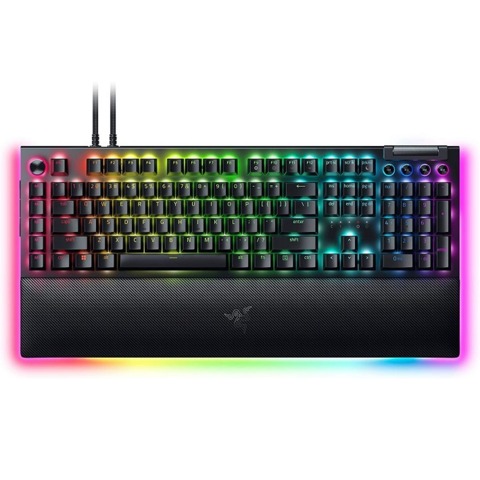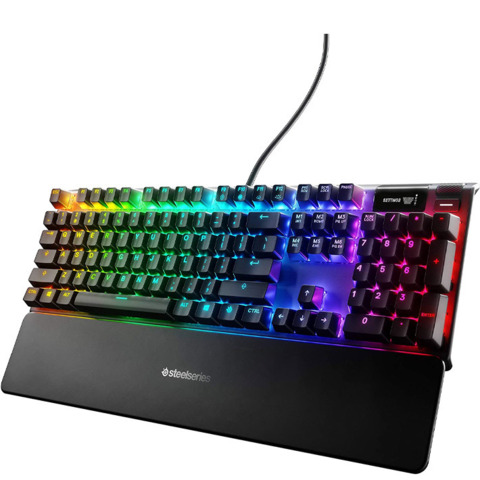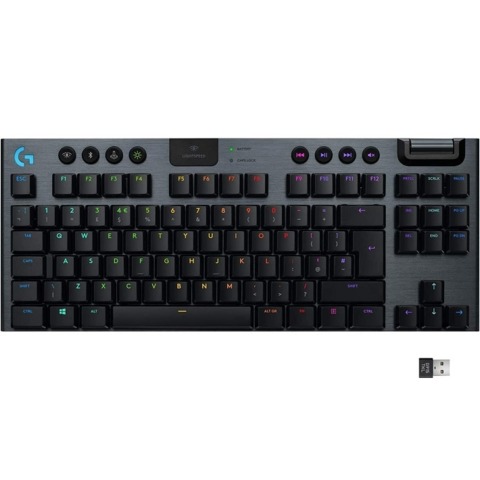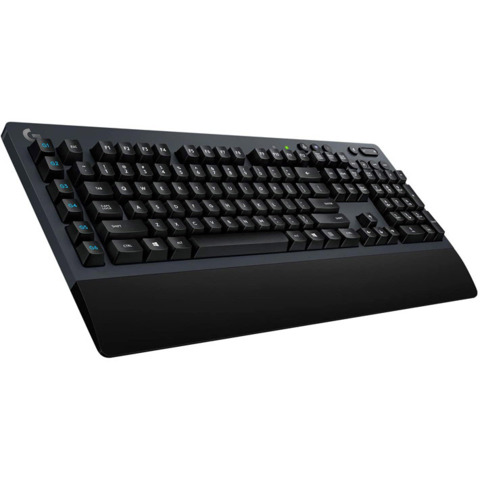If you’re just getting into PC gaming or are looking to upgrade your setup, choosing a gaming keyboard can be more complicated than you might think. Alongside a gaming mouse, your gaming keyboard is the piece of gear that you’ll interact with the most. Plus, you’ll probably also want to use it for activities outside of gaming, so you definitely want a keyboard that feels and looks up to your standards and preferences. To help you out, we’ve rounded up our picks for the best gaming keyboards in 2023.
Between key switches, mechanical vs membrane keyboards, and all the extra features that keyboards tend to come with–such as multimedia keys and RGB lighting–there is a lot to consider. For details on the differences between various keyboard switches, scroll down below the list. Our list of the best gaming keyboards includes wireless and wired options as well as keyboards with different form factors and switches.
Looking to complete your gaming keyboard and mouse combo, or just want more gaming peripherals to shop for? Check out our picks for the best gaming headset and best gaming mouse. If you have a Steam Deck, make sure to check out our roundups of the We also have a list of the best Steam Deck games and best Steam Deck accessories.
Editor’s Note: Article updated on March 1, 2023
SteelSeries Apex 7
The SteelSeries Apex 7 nabs the top spot on our list thanks to a great combination of value and performance. The Apex 7 has a premium build thanks to its “aircraft grade” aluminum alloy materials. Regardless of your preferences for switches, the Apex 7 can accommodate. If you like quiet tactile keys with fast actuation, the brown switches are the ideal choice. For those who want to have tactile switches that provide more audio feedback, opt for the blue. You can also get stealthy linear switches by picking red. The Apex is equipped with anti-ghosting tech and 104 key rollover.
The Apex 7 comes with a magnetic wrist rest for added comfort. It’s one of the best wrist rests we’ve used alongside a gaming keyboard, as it’s ergonomically designed and just the right size to offer enough support while not feeling bulky. Like most keyboards on this list, the Apex 7 has RGB lighting that boasts 16.8 million color options per key.
With five customizable profiles–no additional software required–you can easily cycle through different keyboard input layouts for your favorite games. The Apex 7 has a dedicated media roller, a small OLED display that shows settings, and USB passthrough support.
Razer BlackWidow V4 Pro
The Razer BlackWidow V4 Pro isn’t just one of the newest keyboards on this list–it’s also one of the most expensive. But if you’re willing to up your budget, you’ll get a laundry list of high-end features that make the V4 more than worthy of the iconic BlackWidow name.
As usual, the BlackWidow V4 Pro was built to the high standards of Razer, which means you’re getting doubleshot ABS keycaps, per-key RGB lighting, and even a magnetic plush wrist rest with an underglow effect. But what makes the V4 Pro so compelling it its set of macro keys and the command dial.
These customizable components make it easy to quickly control your on-screen action without having to wade through a series of menus. All told, you’ll have eight macro keys along with four dedicated media keys–so you should have no problem programming the keyboard to fit your needs.
Toss in an aluminum chassis, the option for yellow or green switches, and USB passthrough, and it’s easy to see why the BlackWidow V4 Pro is an excellent, feature-rich gaming keyboard. With a premium build and great comfort/feel, the BlackWidow V4 Pro is worth considering if you don’t mind spending a lot on a gaming keyboard. The only downsides here are that it’s only available as a wired keyboard and the price is very steep.
SteelSeries Apex Pro
The SteelSeries Apex Pro is a high-end keyboard that, on top of looking and feeling the part in basically all respects, sports a pretty innovative feature that currently only exists in maybe one other keyboard: Adjustable mechanical switches. That’s right–you can adjust the trigger point of each individual key on the main key spread to suit your preference, meaning you can program them to only activate on a full, concerted press (about 3.6mm) or the lightest of touches (a shallow 0.4mm).
Is that useful? It can be! A common example would be if you’re a keyboard stickler who spends long stretches of time both typing and playing PC games, like me. You might prefer longer, deeper actuation to help with accuracy and reduce any slips while typing, and a much lighter actuation to increase response times in action games. The SteelSeries Engine software makes it easy to build these profiles (which can be saved onboard the keyboard itself for hardware-side activation), and conveniently allows you to script automatic profile switching for when a particular application becomes active (like Chrome or Apex Legends, for example).
However, it’s worth noting that the linear nature of the switches remains the same regardless, and there are no other options if you prefer a clicky or tactile switch. That said, the way the keys respond can still feel like night and day depending on where you are on the actuation scale.
A host of wholly unnecessary but luxurious features include a tiny OLED display plus a dedicated media playback and volume control wheel, both of which help navigate the onboard UI, which allows you to customise every aspect of the keyboard without having to launch the software, though it’s certainly not as efficient. The display can easily be customised to display 1-bit, 128×40 pixel gifs, and supports integration with a limited selection of programs like Discord, Dota 2, CS:GO, Mortal Kombat 11, and Tidal (if you use Tidal for some reason) to display vital information.
It features USB passthrough, cable routing, macro keys, a magnetic soft rubber wrist rest, and exposed LED lighting for individual keys. The aluminum construction is incredibly durable as you’d expect–it features an exposed keycap design, and it sports a very compact trim, much like the HyperX Alloy Origins (though the lighting isn’t quite as vibrant). Nevertheless, the SteelSeries Apex Pro has everything you’d feasibly want from a premium high-end keyboard, and the adjustable switches are a meaningful customization feature (even if it seems like a ridiculous flex).
As an added bonus, it’s a fair bit cheaper than the BlackWidow V4 Pro while still maintaining high-end features.
(Note: The more affordable Steelseries Apex 7 sports all the features of the Apex Pro, but comes with more traditional SteelSeries-brand Red, Blue, or Brown switches.)
Logitech G915 Wireless
The Logitech G915 Wireless is a high-performing keyboard that doesn’t need cables to keep up with the competition. Thanks to Logitech’s Lightspeed wireless tech, you’ll get responsive performance regardless of what you’re playing.
Featuring a design that’s constructed with aircraft-grade aluminum, five G-keys (macro keys), the availability of several switch types, and a media controller, Logitech didn’t cut any corners with the G915 Wireless. Best of all, you’ll get 30 hours of runtime out of the keyboard before needing a recharge.
Connections can be make via a USB receiver or Bluetooth, giving you a way to connect to multiple devices at once. The G915 is available in both full-size and TKL configurations–both offer incredible performance despite their lack of wires.
Logitech G613
Wireless mechanical keyboards are hard to come by, since there are so few options available. That’s not the only reason why we recommend the Logitech G613, though. Input latency is at the top of concerns, but that’s been largely solved as seen with wireless gaming mice, and Logitech adapts its “Lightspeed” tech found in its mice for the G613. It’s also a fantastic budget gaming keyboard.
The G613 is a full-size keyboard in every sense. It features a built-in plastic wrist rest, which is handy, but not detachable. There are six programmable macro keys on the left side of the keyboard and a suite of media controls at the top-right, too. Most importantly, the G613 stands among the great mechanical keyboards out there because of its fast response and accurate mechanical switches. It only comes with Romer-G tactile switches, which isn’t so bad because these provide all the benefits of a mechanical switch like smooth, consistent keystrokes.
While you’ll need to stock up on AA batteries, the G613 is quite efficient, lasting up to 18 months according to Logitech–it’s so efficient, we’re not even talking in hours anymore. It’d be pretty annoying to swap out batteries for a keyboard every few months, so this is key. A reason why battery life last this long is because one common feature has been left behind: backlit keys. Keys are painted in a vibrant white that helps visibility, but of course it’s not the same as proper backlighting.
Considering its feature set and the fact that it’s wireless, the Logitech G913 is a bargain. Plus it’s almost always on sale nowadays. The prospect a wireless gaming keyboard may not be as appealing as a wireless mouse (you’re not constantly moving a keyboard around and dragging a cord after all), but those who want to cut the cord without sacrificing keyboard quality have a great option here.
Razer DeathStalker V2
Featuring low-profile linear optical switches, the DeathStalker V2 offers a shorter actuation height than most other keyboards. So if you need every keystroke to count and want every edge you can get when playing online, this should be near the top of your list.
Beyond fast actuation, the DeathStalker V2 also offers a slim design that’s complemented by an aluminum top plate for added durability. Combined with a 70-million keystroke lifespan, and it’s clear this piece of gaming gear was designed to last. Keycaps are even outfitted with Razer’s HyperGuard Coating, which helps prevent wear and tear found on standard keyboards.
Razer Chroma, media buttons, a multi-function roller, and detachable USB-C round out the DeathStalker V2 spec list. You’ll also find it in Pro, Regular, and TKL variants, which offer slightly different specs–but all are worthy of joining your battlestation.
Corsair K100 Air Wireless
There’s low-profile, and then there’s the Corsair K100 Air Wireless. Designed with keycaps that resemble laptop keys, the Corsair K100 Air Wireless is radically smaller than most other keyboards on this list, and it’s a great option for someone that wants a board that both functions at a high level yet looks incredible on their desktop.
Cherry MX Ultra Low Profile mechanical switches are the star of the show, offering the short activation distance of just 0.8mm. Each key also features RGB backlighting with adaptive brightness that varies based on the light levels in your room. And beyond your standard QWERTY keys, you’ll also benefit from dedicated media keys and an aluminum volume roller.
You won’t have to worry about running out of juice for the wireless keyboard either, as it can run for 50 hours on a single charge–and that bumps all the way to 200 if you turn off the backlights. All these features come at a price, and the K100 Air gets pretty close to $300. But if you need something sleek with tons of functionality, it simply can’t be beat.
SteelSeries Apex 3 TKL
If you’re for a solid gaming keyboard for under 50 bucks, the SteelSeries Apex 3 is a wonderful option. The Apex 3 features tactile switches that barely make a sound when pressed, so it’s a great option for those who want high-quality switches without the constant clattering while typing.
Even at this price point, the Apex 3 still has some lovely features, including anti-ghosting tech, RGB illumination that’s customizable across eight zones, a water resistant design, media keys, and a volume roller. It also has a cable management system that can help keep your desk looking clean. The Apex 3’s keys are graded for 20 million clicks, so you’re still getting a gaming keyboard that is built to last.
SteelSeries Apex Pro Mini
The Apex Pro Mini packs a lot of keyboard into not a lot of space. One of its coolest features is the ability to map two actions to a single key–with each action tied to a different actuation depth. This makes it easy to map every function you need to just a handful of keys, something you’ll be thankful for as this 60% keyboard lacks directional keys and a number pad.
Beyond assigning two functions to one key, you can also manipulate the overall registration depth of your keys. Whether you want to activate the key at just 0.2mm or hammer your keyboard to 3.8mm, the Apex Pro Mini lets you modify its actuation depths to your heart’s content. It has the same OmniPoint mechanical switches seen in the standard Apex Pro, so you’re essentially getting the same feel, just in a more compact layout.
This high-end keyboard is completed with the inclusion of RGB lights, a durable aluminum alloy top plate, and PBT keypads that’ll withstand everything you throw at them. You can also connect wirelessly or with USB-C, making it easy to get the board up and running with your setup.
Razer BlackWidow V3 Mini HyperSpeed
For the gamer on the go, the Razer Blackwidow V3 is a terrific combination of portability, rugged durability, and satisfying tactile feedback. This keyboard can be connected via Bluetooth, Hyperspeed Wireless, or through a traditional USB-C cable, has up to 200 hours of battery life, and can be topped up with a fresh supply of electricity in a handful of hours.
As for the keys, Razer’s Yellow mechanical switches mean that you can hammer away at the opposition while enjoying its low sound profile, and the doubleshot ABS keycaps will ensure that the labeling never wears off with repeated use.
Razer Ornata
Mecha-membrane keyboards are the black sheep of the gaming world, but they can still offer solid performance at reasonable prices. The Razer Ornata Chroma offers the perfect mix of performance and price, as it rolls great features into an affordable package.
The high-performance mecha-membrane switches are the best part of the Ornata, as they couple the tactile feedback typically reserved for mechanical keyboards with the comfort of a membrane keyboard. They’re also rated for 80 million clicks (and backed by a two-year warranty).
Razer didn’t skip on the extras, either, outfitting the Ornata with a magnetic wrist rest, support for Razer Synapse, customizable RGB lights, and a sleek design that matches its mechanical cousins. There are plenty of other great products on this list, but if you’re married to mecha-membrane keyboards, this is the one for you.
Keyboard switches, explained
Different types of switches will appeal to different and whether you’re going with a Cherry MX switch like Cherry MX Red or Cherry MX Blue, there are plenty of keyboards worth your time. It can get confusing quickly, especially if you can’t test these keyboards yourself and truly tell the difference with your own fingers. Thankfully, it’s easy to understand exactly what you’ll be getting if you understand the terminology.
First off, linear versus tactile switches keys. Linear means there is no physical feedback mechanism to indicate when a keystroke is registered. It’s smooth, relatively quiet, and preferred for rapidly tapping on keys. Tactile means there is a bump or click to indicate you’ve hit the actuation point; it’s louder, but some prefer having physical feedback for keystrokes. It really comes down to preference. Actuation point is the distance at which a keystroke is registered; a shorter distance means you don’t have to press the key down as far, but can lead to errant inputs. Actuation force is, well, the force needed to press the key down. Of course, there are all the quality-of-life considerations to think about, too, like multimedia keys, whether you want a programmable key row and such.
While Cherry has been the long-time dominant manufacturer of mechanical switches, some gaming peripheral brands have started making their own proprietary mechanical switches for their keyboards, namely Razer and Logitech. For a brief overview of the most common mx switches, see below:
- Cherry MX Red Switches: Linear
- Cherry MX Blue Switches: Tactile and Clicky
- Cherry MX Brown Switches: Tactile with a Bump
- Cherry MX Speed Switches: Linear with a very short actuation point
- Romer-G Linear Switches: Linear
- Romer-G Tactile Switches: Tactile with a Bump
- Razer Yellow Switches: Linear
- Razer Orange Switches: Tactile with a Bump
- Razer Green Switches: Tactile and Clicky
- Steelseries OmniPoint Adjustable Switches: Linear with adjustable actuation point
The products discussed here were independently chosen by our editors.
GameSpot may get a share of the revenue if you buy anything featured on our site.











